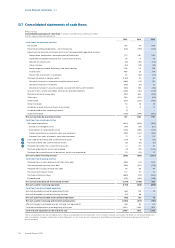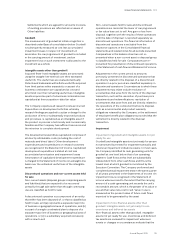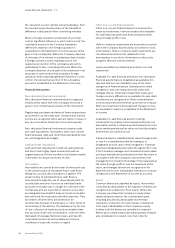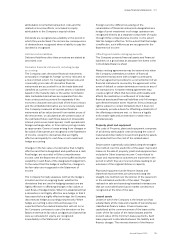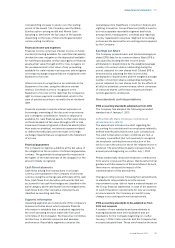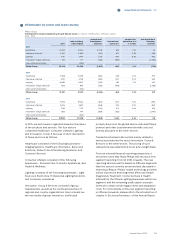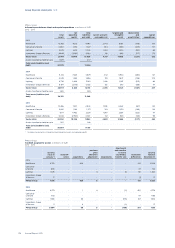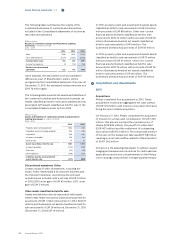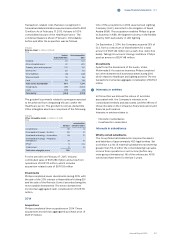Philips 2015 Annual Report Download - page 120
Download and view the complete annual report
Please find page 120 of the 2015 Philips annual report below. You can navigate through the pages in the report by either clicking on the pages listed below, or by using the keyword search tool below to find specific information within the annual report.Group nancial statements 12.9
120 Annual Report 2015
cost is charged to the Statement of income over the
lease period so as to produce a constant periodic rate
of interest on the remaining balance of the liability for
each period. The corresponding rental obligations, net
of nance charges, are included in other short-term and
other non-current liabilities. The property, plant and
equipment acquired under nance leases is
depreciated over the shorter of the useful life of the
assets and the lease term.
Leases in which the Company is the lessee and in which
substantially all risks and rewards of ownership are
retained by the lessor are classied as operating leases.
Payments made under operating leases (net of any
incentives received from the lessor) are recognized in
the Statement of income on a straight-line basis over
the term of the lease.
Inventories
Inventories are stated at the lower of cost or net
realizable value. The cost of inventories comprises all
costs of purchase, costs of conversion and other costs
incurred in bringing the inventories to their present
location and condition. The costs of conversion of
inventories include direct labor and xed and variable
production overheads, taking into account the stage of
completion and the normal capacity of production
facilities. Costs of idle facility and abnormal waste are
expensed. The cost of inventories is determined using
the rst-in, rst-out (FIFO) method. Inventory is
reduced for the estimated losses due to obsolescence.
This reduction is determined for groups of products
based on purchases in the recent past and/or expected
future demand.
Employee benet accounting
A dened contribution plan is a post-employment
benet plan under which an entity pays xed
contributions into a separate entity and will have no
legal or constructive obligation to pay further amounts.
Obligations for contributions to dened contribution
pension plans are recognized as an employee benet
expense in the Statement of income in the periods
during which services are rendered by employees.
A dened benet plan is a post-employment benet
plan other than a dened contribution plan. Plans for
which the Company has no legal or constructive
obligation to pay further amounts, however for which
contributions paid by the Company are not xed, are
also treated as dened benet plan. The net pension
asset or liability recognized in the Consolidated
balance sheets in respect of dened benet post-
employment plans is the fair value of plan assets less
the present value of the projected dened benet
obligation (DBO) at the balance sheet date. The
projected dened benet obligation is calculated
annually by qualied actuaries using the projected unit
credit method. Recognized assets are limited to the
present value of any reductions in future contributions
or any future refunds.
For the Company’s major plans, a full discount rate
curve of high-quality corporate bonds is used to
determine the dened benet obligation. The curves
are based on Towers Watson’s RATE:Link methodology
which uses data of corporate bonds rated AA or
equivalent. For the other plans a single point discount
rate is used based on corporate bonds for which there
is a deep market and the plan’s maturity. Plans in
countries without a deep corporate bond market use a
discount rate based on the local sovereign curve and
the plan’s maturity.
Pension costs in respect of dened benet post-
employment plans primarily represent the increase of
the actuarial present value of the obligation for post-
employment benets based on employee service
during the year and the interest on the net recognized
asset or liability in respect of employee service in
previous years.
Remeasurements of the net dened benet liability
comprise actuarial gains and losses, the return on plan
assets (excluding interest) and the eect of the asset
ceiling (excluding interest). The Company recognizes all
remeasurements in Other comprehensive income.
The Company recognizes gains and losses on the
settlement of a dened benet plan when the
settlement occurs. The gain or loss on settlement is the
dierence between the present value of the dened
benet obligation being settled, as determined on the
date of settlement, and the settlement price, including
any plan assets transferred and any payments made
directly by the Company in connection with the
settlement. In this respect, the amount of the plan
assets transferred is adjusted for the eect of the asset
ceiling. Past service costs following from the
introduction of a change to the benet payable under
a plan or a signicant reduction of the number of
employees covered by a plan (curtailment), are
recognized in full in the Statement of income.
Short-term employee benet obligations are measured
on an undiscounted basis and are expensed as the
related service is provided. The Company recognizes a
liability and an expense for bonuses and incentives
based on a formula that takes into consideration the
prot attributable to the Company’s shareholders after
certain adjustments.
The Company’s net obligation in respect of long-term
employee benets is the amount of future benet that
employees have earned in return for their service in the
current and prior periods, such as jubilee entitlements.
That benet is discounted to determine its present
value. Remeasurements are recognized in the
Statement of income in the period in which they arise.
Share-based payment
The grant-date fair value of equity-settled share-
based payment awards granted to employees is
recognized as personnel expense, with a


